Fashion AI is transforming textile design by blending algorithmic precision with creative artistry. In an industry steeped in tradition, the integration of artificial intelligence into fabric creation and pattern development is opening new frontiers for designers, manufacturers, and brands alike. Fashion AI is not just enhancing the aesthetics of textiles; it is redefining how we conceive, create, and produce them.
The Intersection of Data and Design
Textile design has always balanced artistry with functionality. Historically, designers relied on manual sketching, weaving techniques, and cultural references to produce patterns that resonated with their audiences. Today, fashion AI adds a powerful layer to this process by introducing data-driven creativity.
Through machine learning algorithms, fashion AI analyzes massive datasets of historical patterns, color combinations, and consumer preferences. This enables the generation of entirely new patterns that align with current trends while honoring traditional motifs. For example, a brand can input data from vintage fabrics, social media trends, and regional aesthetics to produce a collection that feels both familiar and innovative.
Fashion AI and Custom Pattern Generation
One of the most exciting developments in fashion AI is the ability to generate custom textile patterns tailored to specific brand identities or customer preferences. AI-powered design tools can create unique prints based on input parameters such as mood, season, or cultural inspiration.
This customization extends beyond mere aesthetics. Fashion AI can optimize patterns for different fabric types, ensuring that prints maintain their vibrancy, alignment, and integrity across various materials. This leads to a more cohesive and high-quality final product, reducing trial-and-error in the design process.
Additionally, brands can use fashion AI to produce limited-edition prints or hyper-personalized designs for niche markets. This level of personalization fosters stronger connections with consumers, who increasingly seek unique products that reflect their individual tastes and values.
Enhancing Sustainability Through Smart Design
Sustainability is a critical concern in textile production, and fashion AI contributes by optimizing design for minimal waste. Algorithms can suggest pattern layouts that maximize fabric usage, reducing offcuts and minimizing waste in the manufacturing process.
Fashion AI also assists in selecting eco-friendly materials that align with design goals. By analyzing environmental data, AI can recommend sustainable fabric options and dyeing processes that lower the carbon footprint. This makes it easier for brands to integrate sustainability into their core design philosophy without compromising on creativity.
Moreover, AI-generated simulations can predict how patterns will interact with different fabric textures and garment silhouettes. This ensures that the design-to-production pipeline is more efficient and environmentally conscious, further supporting the movement towards sustainable fashion.
Tradition Meets Technology
Fashion AI doesn’t replace the designer’s creative vision; instead, it acts as a collaborator that enhances artistic expression. By providing designers with algorithmically generated ideas, AI can spark new directions that might not have been explored through traditional methods.
For instance, a designer inspired by indigenous patterns can use AI to explore variations that respect cultural significance while introducing modern elements. This fusion of technology and tradition results in textiles that are rich in heritage yet innovative in execution.
The Future of Textile Design with Fashion AI
As fashion AI continues to evolve, we can expect even more advanced tools that allow for real-time collaboration between designers and algorithms. Future applications may include voice-activated design adjustments, augmented reality interfaces for pattern visualization, and AI-driven predictions on pattern popularity.
This technological evolution will democratize textile design, enabling smaller brands and independent designers to access high-level design capabilities without needing extensive resources. It will also facilitate faster iterations, reducing time-to-market and increasing creative agility.
Fashion AI is revolutionizing textile design by merging data, creativity, and sustainability into one dynamic process. By leveraging AI tools, designers can push the boundaries of what’s possible in pattern creation, resulting in textiles that are not only visually stunning but also environmentally responsible and culturally informed.
As the fashion industry moves forward, the synergy between human creativity and artificial intelligence will continue to shape the future of fabric and pattern design. Fashion AI stands at the forefront of this transformation, turning code into canvas and algorithms into artistry.
